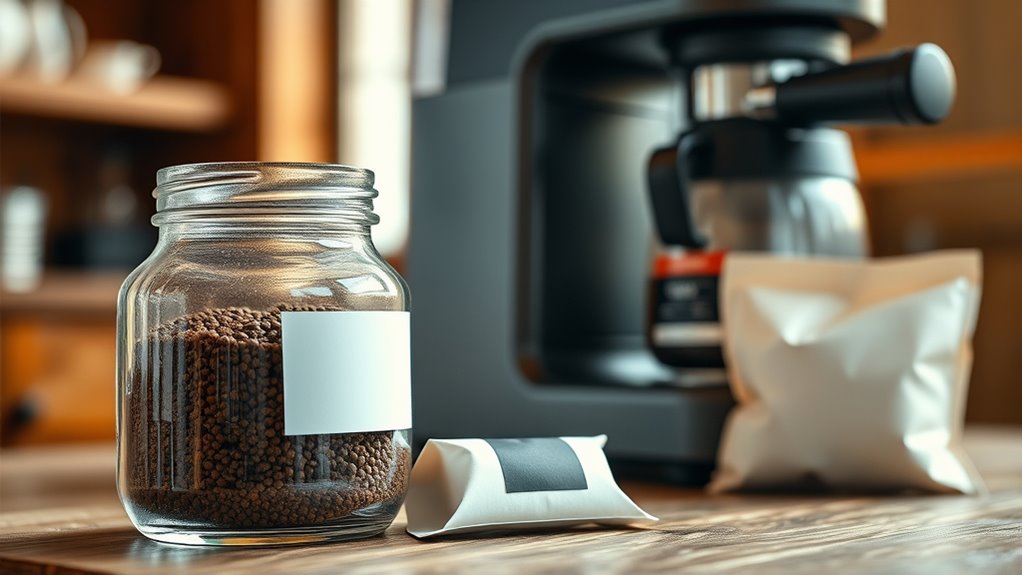The history of instant coffee shows a continuous balancing act between convenience and flavor. You’ll find that early innovations aimed to make coffee quick and affordable, often sacrificing taste. Despite technological advances like freeze-drying improving quality over the years, many still associate instant coffee with lower flavor than fresh brews. If you want to uncover how this centuries-long trade-off evolved and shaped your favorite quick caffeine fix, there’s more to explore.
Key Takeaways
- Early instant coffee faced criticism for poor flavor, emphasizing convenience over quality in its initial stages.
- Technological innovations like freeze-drying significantly improved flavor retention and product quality over time.
- Market demand for quick, affordable coffee drove rapid expansion despite ongoing perceptions of lower taste.
- Continuous research and advanced processing methods aim to bridge the flavor gap between instant and fresh coffee.
- Instant coffee’s evolution reflects a balance between enhancing quality and maintaining its core advantage of convenience.

The history of instant coffee is a story of innovation driven by the desire for quick, convenient caffeine. You might be surprised to learn that the idea dates back to 1771 when Britain first mentioned a “coffee compound” and even granted a patent for it. Over the years, inventors experimented with different methods, like Camp Coffee produced in Scotland in 1876, which combined coffee with chicory essence.
Instant coffee’s roots trace back to 1771, with early patents and inventive methods shaping its history.
Then, in 1889, David Strang filed a patent for soluble coffee, and a year later, he developed the “Dry Hot-Air” process in New Zealand. During the American Civil War, essence of coffee was used, but it didn’t win many fans, mainly because of its unappealing taste.
In 1901, Satori Kato amazed audiences at the Pan-American Exposition in Buffalo by introducing powdered instant coffee. Around this time, George Constant Louis Washington worked in Guatemala, trying to perfect instant coffee, and by 1910, he was selling it commercially.
Despite its growing popularity, early instant coffee faced criticism for lacking flavor, which kept many coffee enthusiasts skeptical. Then, in 1933, Nestlé stepped in to mass-produce instant coffee, initially called Nescafé, to help Brazil handle its coffee surplus. The launch of Nescafé in 1938 marked a turning point, making instant coffee more accessible worldwide.
Post-World War II, technological advances such as high-vacuum freeze-drying revolutionized instant coffee production, dramatically improving taste and quality. Manufacturing processes continued to evolve throughout the 1940s and 50s, with freeze-dried varieties like Taster’s Choice becoming popular in the 1960s for their freshness. The development of such advanced drying techniques was crucial in overcoming flavor limitations.
These innovations helped instant coffee shed its reputation as a cheap, low-quality product, transforming it into a global staple embraced for its convenience. Technological improvements like vacuum freeze-drying, better powder technology, and advanced packaging extended shelf life and preserved flavors.
Automation streamlined production, making it more efficient and affordable. Meanwhile, the global market expanded rapidly, driven by the appeal of quick preparation and low cost, especially in regions with coffee surpluses. Instant coffee also influenced culinary traditions, sometimes replacing traditional brewing methods and altering cultural norms.
Its affordability and ease of use attracted a broad range of consumers, while marketing strategies helped cement its place in daily routines. Despite these advancements, many still perceive instant coffee as less flavorful than freshly brewed options. Consumers often prioritize convenience over taste, but ongoing innovations aim to bridge that gap.
Cheaper and faster to prepare, instant coffee became a cultural phenomenon, shaping how people consume caffeine worldwide. Its history reflects a continuous balancing act between quality and convenience, driven by technological progress and changing consumer preferences.
Frequently Asked Questions
How Does Instant Coffee Preserve Its Freshness Over Time?
You can keep your instant coffee fresh by storing it in a cool, dark, and dry place, ideally in an airtight container. Make sure to avoid temperature fluctuations and humidity, which cause clumping and flavor loss.
Using sealed, opaque containers and keeping the coffee away from light and moisture helps preserve its aroma and taste over time. Proper storage extends shelf life and maintains quality, even after opening.
What Are the Environmental Impacts of Instant Coffee Production?
You should know that instant coffee production impacts the environment in several ways. It consumes a lot of energy, especially during roasting, drying, and processing, often relying on fossil fuels.
Farming practices can lead to deforestation, soil degradation, and water use. While transport emissions are lower due to its concentrated form, the overall process contributes to greenhouse gases, chemical runoff, and resource depletion, affecting ecosystems and climate.
Are There Health Benefits Associated With Instant Coffee Consumption?
You might wonder if instant coffee offers health benefits. It does, as it’s linked to a reduced risk of type 2 diabetes, heart disease, and certain cancers. Drinking 3-5 cups daily can lower early death risk, and decaf versions provide similar benefits.
Instant coffee also contains antioxidants that help reduce inflammation, and it can boost alertness and energy, making it a convenient way to support your health when consumed in moderation.
How Does Instant Coffee Compare Nutritionally to Brewed Coffee?
Imagine choosing between a quick, pre-packed snack and a fresh homemade meal. Instant coffee is like the snack—convenient but offering fewer nutrients. Brewed coffee is the homemade dish—richer in antioxidants, chlorogenic acid, and flavor.
It provides higher caffeine and more health benefits, but takes longer to prepare. So, if you value nutrients and taste, brewed coffee wins; if convenience is key, instant coffee suits you.
What Innovations Are Emerging in the Instant Coffee Industry?
You’ll notice that the instant coffee industry is evolving with exciting innovations. Advanced freeze-drying preserves fresh flavors, while single-origin and specialty Arabica beans boost quality.
Artisanal techniques and eco-friendly processes enhance premium appeal. Cold brew and plant-based ingredients offer new flavor profiles.
Packaging becomes more sustainable and attractive, and digital technologies improve consistency and accessibility. These innovations aim to satisfy your desire for high-quality, convenient, and eco-conscious coffee experiences.
Conclusion
As you take that first warm sip, you feel the comforting aroma swirl around you, a quick escape to mornings past and moments of ease. Instant coffee, with its blend of convenience and nostalgia, offers a fleeting taste of simplicity in a busy world. Though it may lack the rich depth of freshly brewed beans, it remains a symbol of how technology transforms your daily ritual, turning chaos into comfort with just a flick of a cup.









